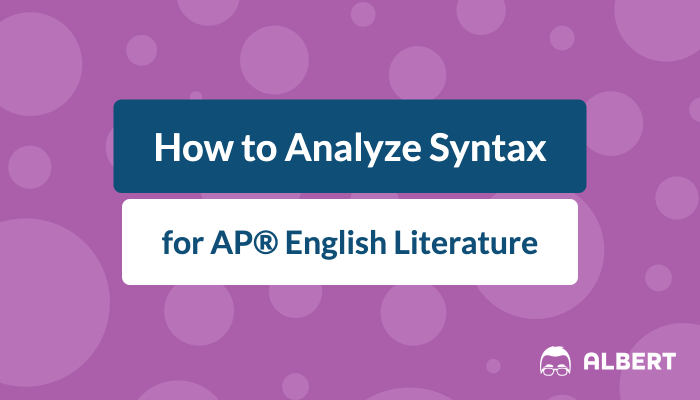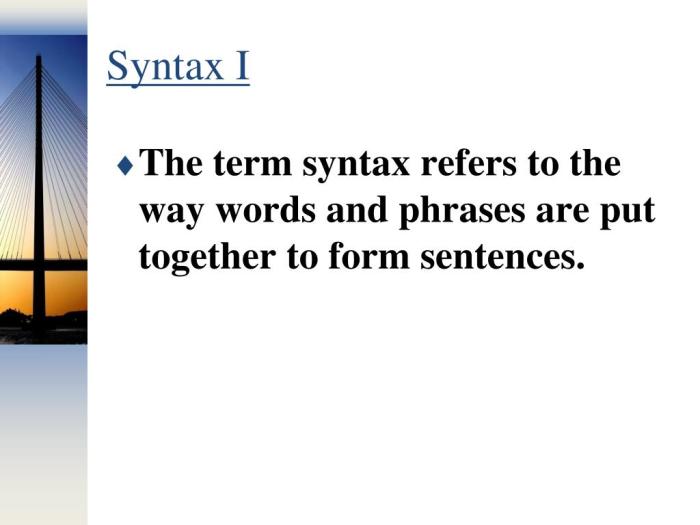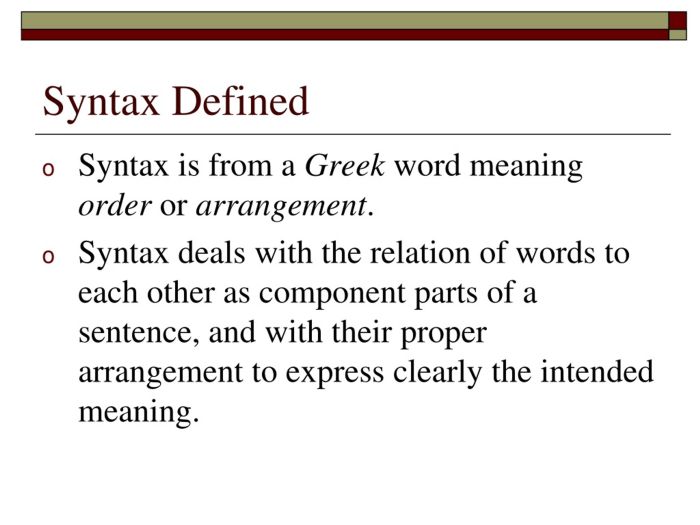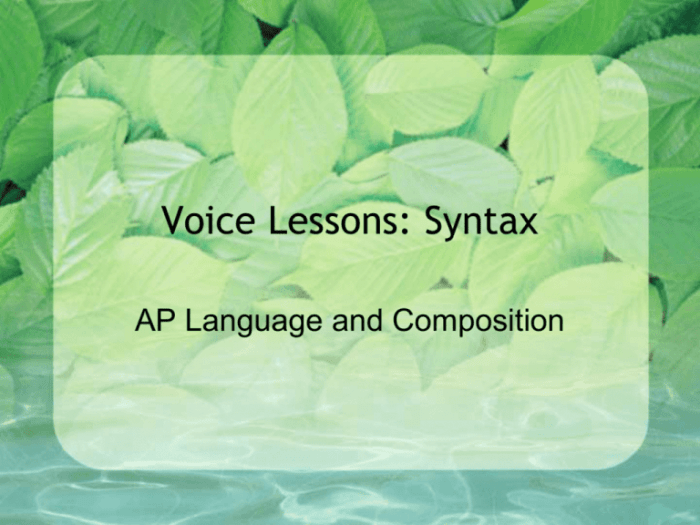Types of syntax AP Lang embarks on an enlightening journey, unraveling the intricacies of language and providing a comprehensive guide to the diverse elements that shape our communication.
From sentence structures to word types, this exploration delves into the fundamental building blocks of language, equipping you with a deeper understanding of how words come together to convey meaning and create impact.
Sentence Types

Sentences are the building blocks of language, conveying ideas and expressing thoughts. In English, there are various types of sentences, each with distinct characteristics and structures. Understanding these sentence types is crucial for effective communication, both in writing and speaking.
Sentences can be categorized based on their purpose, structure, and the type of clause they contain. Let’s explore the different types of sentences in detail:
Declarative Sentences
Declarative sentences make a statement or assertion. They typically end with a period (.) and convey information or express an opinion. For example:
- The sun is shining brightly.
- I enjoy reading novels.
- The meeting will start at 10:00 AM.
Interrogative Sentences
Interrogative sentences ask a question and typically end with a question mark (?). They are used to seek information or clarification. For example:
- Where is the library located?
- What is your favorite color?
- Can you please pass me the salt?
Exclamatory Sentences
Exclamatory sentences express strong emotions or surprise and end with an exclamation mark (!). They are used to emphasize a feeling or reaction. For example:
- Wow, that was an amazing performance!
- Oh no, I forgot my keys!
- What a beautiful day!
Imperative Sentences
Imperative sentences give a command, request, or instruction. They typically end with a period (.) and do not have a subject. For example:
- Close the door, please.
- Turn left at the next intersection.
- Please be quiet.
Phrase Types: Types Of Syntax Ap Lang

Phrases are groups of related words that do not include a subject and a verb. They function as a single unit within a sentence and can serve various purposes, such as modifying nouns, verbs, or adjectives.
There are several types of phrases, each with its own distinct structure and function:
Noun Phrases
Noun phrases act as nouns within a sentence. They can function as subjects, objects, or modifiers. Noun phrases typically consist of a noun or pronoun as the headword, along with modifiers such as adjectives, determiners, or other nouns.
- The happy childrenplayed in the park.
- I gave the bookto my friend.
- The house on the hillis beautiful.
Verb Phrases
Verb phrases function as verbs within a sentence. They consist of a main verb, along with auxiliary verbs (such as “have,” “has,” “had,” “do,” “does,” or “did”) or modals (such as “can,” “could,” “may,” “might,” “must,” or “should”).
- She is singinga song.
- I have been studyingfor the test.
- You should have finishedyour homework by now.
Adjective Phrases
Adjective phrases modify nouns or pronouns by describing or limiting their meaning. They typically consist of an adjective as the headword, along with modifiers such as adverbs or prepositional phrases.
- The very tallman stood out in the crowd.
- The beautifully decoratedroom was perfect for the party.
- The extremely intelligentstudent excelled in all subjects.
Adverb Phrases
Adverb phrases modify verbs, adjectives, or other adverbs by providing additional information about their manner, place, or time. They typically consist of an adverb as the headword, along with modifiers such as prepositions or other adverbs.
- The children played happilyin the park.
- The car drove slowlydown the street.
- I will meet you tomorrowat the library.
Prepositional Phrases
Prepositional phrases consist of a preposition followed by a noun phrase or pronoun. They function as adjectives or adverbs, providing additional information about the subject, verb, or other elements in the sentence.
- The book is on the table.
- I went to the storeto buy groceries.
- The students studied for the test.
Clause Types

Clauses are the building blocks of sentences. They are groups of words that contain a subject and a verb and express a complete thought. Clauses can be either independent or dependent.
Independent clauses can stand alone as a sentence. They express a complete thought and do not need any other words to make sense. For example:
- The cat sat on the mat.
- The dog barked at the mailman.
- The children played in the park.
Dependent clauses cannot stand alone as a sentence. They do not express a complete thought and need to be attached to an independent clause to make sense. For example:
- Because the cat was hungry
- Who barked at the mailman
- That the children played in
There are three main types of dependent clauses:
- Noun clauses
- Adjective clauses
- Adverb clauses
Noun clauses act as nouns in a sentence. They can be used as subjects, objects, or complements. For example:
- That the cat was hungry was obvious.
- I know that the dog barked at the mailman.
- The children said that they played in the park.
Adjective clauses modify nouns or pronouns. They tell us more about the noun or pronoun they are attached to. For example:
- The cat that was hungry sat on the mat.
- The dog who barked at the mailman was a German shepherd.
- The children who played in the park were having a lot of fun.
Adverb clauses modify verbs, adjectives, or other adverbs. They tell us more about the action, quality, or manner of the verb, adjective, or adverb they are attached to. For example:
- The cat sat on the mat because it was hungry.
- The dog barked at the mailman because he was scared.
- The children played in the park although it was raining.
Word Types

Word types, also known as parts of speech, are the building blocks of language. They provide the structure and meaning to sentences. There are eight main word types: nouns, verbs, adjectives, adverbs, pronouns, prepositions, conjunctions, and interjections.Each word type has its own unique characteristics and functions.
Nouns are words that name people, places, things, or ideas. Verbs are words that describe actions or states of being. Adjectives are words that describe nouns or pronouns. Adverbs are words that describe verbs, adjectives, or other adverbs. Pronouns are words that take the place of nouns.
Prepositions are words that show the relationship between a noun or pronoun and another word in the sentence. Conjunctions are words that connect words, phrases, or clauses. Interjections are words that express strong emotions.Here is a table summarizing the different word types, their functions, and characteristics:| Word Type | Function | Characteristics ||—|—|—|| Noun | Names people, places, things, or ideas | Common nouns (e.g.,
dog, car, book) and proper nouns (e.g., John, New York, the Bible) || Verb | Describes actions or states of being | Action verbs (e.g., run, jump, think) and linking verbs (e.g., be, seem, appear) || Adjective | Describes nouns or pronouns | Can be positive (e.g.,
There are various types of syntax in AP Lang, such as declarative, interrogative, imperative, and exclamatory. Incidentally, have you heard of the pai gow tiles house way ? It’s an interesting variation of the Chinese game pai gow. Getting back to syntax in AP Lang, it’s crucial to understand these different types to effectively analyze and construct sentences.
good, beautiful, smart) or negative (e.g., bad, ugly, stupid) || Adverb | Describes verbs, adjectives, or other adverbs | Can be positive (e.g., quickly, slowly, well) or negative (e.g., slowly, badly, hardly) || Pronoun | Takes the place of a noun | Personal pronouns (e.g.,
I, you, he, she, it) and possessive pronouns (e.g., my, your, his, her, its) || Preposition | Shows the relationship between a noun or pronoun and another word in the sentence | Common prepositions include of, to, from, by, at, and in || Conjunction | Connects words, phrases, or clauses | Common conjunctions include and, but, or, nor, for, and so || Interjection | Expresses strong emotions | Common interjections include wow, ouch, and hey |Word types are essential for understanding the structure and meaning of sentences.
By understanding the different word types and their functions, you can become a more effective communicator.
Punctuation

Punctuation is crucial for sentence structure, enhancing clarity and conveying meaning effectively. It provides visual cues that guide readers through the text, indicating pauses, emphasis, and grammatical relationships.
Various punctuation marks serve specific purposes. Commas (,) separate elements in a series, indicate nonessential clauses, and prevent ambiguity. Periods (.) end sentences, indicating a complete thought. Semicolons (;) connect closely related independent clauses and separate items in a list when commas would cause confusion.
Commas
- Separate items in a series: “I need apples, bananas, and oranges.”
- Set off nonessential clauses: “The dog, who was very excited, wagged its tail.”
- Prevent ambiguity: “The children ate the pizza, and the adults drank wine.”
Periods
- End declarative sentences: “The sun is shining.”
- End imperative sentences: “Close the door.”
- End interrogative sentences: “Where are you going?”
Semicolons, Types of syntax ap lang
- Connect independent clauses: “The weather was cold; the wind was howling.”
- Separate items in a list when commas would cause confusion: “The students are studying for exams: math, science, and history.”
Query Resolution
What is the difference between a sentence and a phrase?
A sentence is a complete thought that expresses a subject, verb, and complete idea. A phrase is a group of related words that does not express a complete thought.
What are the four types of clauses?
Independent clauses can stand alone as a sentence. Dependent clauses cannot stand alone as a sentence and must be attached to an independent clause.
What are the eight parts of speech?
Nouns, pronouns, verbs, adjectives, adverbs, prepositions, conjunctions, and interjections
